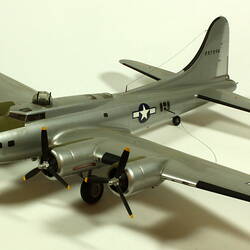Summary
Model History
1:12 scale model of a Wright Cyclone R-1820-C9HE engine, commissioned by the Museum of Victoria and built by Mr R.D. Ramsay in 1960. It is mounted on a model servicing stand. It is believed to be made from a Monogram plastic model kit.
Engine History
The Wright Cyclone series of nine cylinder, air cooled radial aero engines were developed continuously between the 1920s and 1940s by the Wright Aeronautical Corporation, a division of the Curtiss-Wright Corporation in the USA. Various models of the Cyclone were used on civilian and military aircraft such as the Douglas DC-2 and early production DC-3 airliners and the Boeing B-17 Flying Fortress bomber. Production increased sharply after 1939 to meet military orders with some 200,000 engines being made by the company between 1939 and 1944. The 'H' series engines were the final wartime development of the Cyclone.
In Australia, Wright engines had established a reputation for reliable service following the exploits of Charles Kingsford Smith's Fokker F.VII/3m 'Southern Cross' which was fitted with three Wright J-5 Whirlwind engines for its trans-Pacific flight in 1927. The Cyclone powered DC-2 and DC-3 airliners in Australia during the 1930s as well as the Lockheed Hudson bomber ordered for the RAAF. In December 1941 the only fighter aircraft operated by the RAAF in South East Asia at the time of the Japanese assault were the Cyclone powered Brewster Buffalo aircraft of 21 and 453 Squadrons in Malaya. These aircraft were completely inadequate in most respects as fighters but were not improved by overheating and oil leaks from their engines, some of which were found to be used examples taken from civilian aircraft. The C9HE model engine was produced between 1950 and 1963 delivering 1475 horsepower.
More Information
-
Collecting Areas
-
Acquisition Information
Purchase
-
Modelmaker
-
Designer of Item Modelled
Wright Aeronautical Corp, United States of America
Engine Designer. -
Manufacturer of Item Modelled
Curtiss-Wright Corporation, United States of America
Engine Builder. -
Brand Names
-
Classification
Air transport, Aero engines, Model reciprocating propeller engines
-
Category
-
Discipline
-
Type of item
-
Overall Dimensions
100 mm (Length), 100 mm (Width), 100 mm (Height)
-
Keywords
Aero Engines, Internal Combustion Engines, Model Aero Engines, Scale Models, Wars & Conflicts


